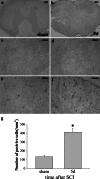Expression of Peroxiredoxin 1 After Traumatic Spinal Cord Injury in Rats
- PMID: 26003307
- PMCID: PMC11486328
- DOI: 10.1007/s10571-015-0214-6
Expression of Peroxiredoxin 1 After Traumatic Spinal Cord Injury in Rats
Abstract
Reactive astrogliosis and microgliosis after spinal cord injury (SCI) contribute to glial scar formation that impedes axonal regeneration. The mechanisms underlying reactive astrocyte and microglia proliferation upon injury remain partially understood. Peroxiredoxin 1 (PRDX1) is an antioxidant participating in cell proliferation, differentiation, and apoptosis. However, PRDX1 functions in SCI-induced astrocyte and microglia proliferation are unknown. In this study, we established an acute spinal cord contusion injury model in adult rats to investigate the potential role of PRDX1 during the pathological process of SCI. We found the palpable expression increase of PRDX1 after SCI by western blot and immunohistochemistry staining. Double immunofluorescence staining showed that PRDX1 expression mainly increased in astrocytes and microglia. In addition, PRDX1/proliferating cell nuclear antigen (PCNA) colocalized in astrocytes and microglia. Furthermore, PCNA expression also elevated after SCI, as well as was positively correlated with PRDX1 expression. In vitro, PRDX1 expression in primary rat spinal cord astrocytes and microglia changed in a concentration- and time-dependent manner according to LPS treatment. In addition, PRDX1 knockdown in astrocytes and microglia resulted in the decrease of PCNA expression after LPS stimulation, showing that PRDX1 promoted astrocyte and microglia proliferation after inflammation. Our results suggested that PRDX1 might play a crucial role in astrocyte and microglia proliferation after SCI.
Keywords: Glial cell proliferation; Peroxiredoxin 1 (PRDX1); Rats; Spinal cord injury (SCI).
Figures







References
-
- Basso DM, Beattie MS, Bresnahan JC (1995) A sensitive and reliable locomotor rating scale for open field testing in rats. J Neurotrauma 12(1):1–21 - PubMed
-
- Becher B, Prat A, Antel JP (2000) Brain-immune connection: immuno-regulatory properties of CNS-resident cells. Glia 29(4):293–304 - PubMed
-
- Castriotta RJ, Murthy JN (2009) Hypoventilation after spinal cord injury. Semin Respir Crit Care Med 30(3):330–338 - PubMed
MeSH terms
Substances
LinkOut - more resources
Full Text Sources
Medical
Miscellaneous

